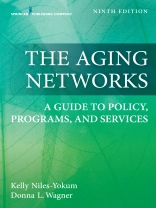Praise for the Eighth Edition:
“This small volume is not only an excellent learning tool, but also a ‘must-have’ handbook for aging professionals in many fields.”
-Noreen A. Shugrue
Research Associate, University of Connecticut Center on Aging
Farmington, CT
Educational Gerontology
This classic text—more relevant than ever as our population rapidly ages—delivers comprehensive and up-to-date knowledge about aging services in the U.S. Written for both students and practitioners of gerontology, along with all professionals involved in the well-being of older adults, this highly accessible book provides a current and detailed description and analysis of local to global services for older people with or without cognitive, physical, or social needs.
The Ninth Edition is updated to reflect critical changes to legislation, health care, and recent trends. It focuses on the strengths and diversity of older adults and the role our multilayered aging networks play in advocacy, community independence, and engagement. Commentary and critical thinking challenges from policymakers, program directors, and educators facilitate high-level reasoning and independent analysis of aging networks past, present, and future. The ninth edition also offers enhanced resources including a Test Bank, Instructor’s Manual, Power Point slides, and links to video. Additionally, the print version of the book includes free, searchable, digital access to the entire contents.
New to the Ninth Edition:
- Fully updated to reflect historical context, recent trends and challenges, and future considerations
- Addresses the effects of our current political and ideological landscape on aging networks including a Call to Action
- Examines the current status of Medicare and Medicaid, Meals-on-Wheels, and the impact of the ACA
- Discusses long-term services and supports, disaster preparedness and climate change, caregiving as a human right, and LBGTQ services and support
- Presents new case studies providing evidence-based best-practice initiatives and new innovations
- Delivers enhanced instructor resources including Test Bank, Instructor’s Manual, Power Point slides, and video links
Key Features:
- Focuses on the strengths of older adults and the role our multilayered aging networks play in advocacy, community independence, and engagement
- Provides commentary and critical thinking challenges from policy-makers, program directors, and educators to facilitate high-level analysis
- Addresses changing demographics and future challenges
- Offers “Voices from the Field” boxes and “Critical Thinking” topics and questions to encourage reflection and discussion
Table of Content
CONTENTS
Preface
Acknowledgments
Introduction
Section I. Older Americans and the Aging Networks
1. Changing Demand Demographics
Section II. Older Americans Act Legislation and the Aging Networks—A New Era
2. Older Americans Act Legislation and an Expanding Consumer Base: The Evolution of a Network
Section III. Community-Based Services—The New Landscape
3. Community-Based Services and the Aging Networks
4. The Rights and Well-Being of Older Americans
Section IV. Our Aging Future—Survival, Sustainability, and Success
5. The Future Is Now: Workforce Issues of the Aging Networks
6. Our Aging World and the Challenge of Change
7. Our Aging Future—Persistent and Emerging Issues for the Aging Networks: A Call to Action
Appendix A: State Units on Aging
Appendix B: Administration on Aging Regional Support Centers
Appendix C: National Aging Network Organizations and Resources
Appendix D: Classroom Assignments
Appendix E: Model and Evidenced-Based Programs
Index
About the author
Donna L. Wagner, Ph D, is the interim dean of the College of Health and Social Services, New Mexico State University. Prior to this she was the founding director of gerontology, Towson University, Maryland.












